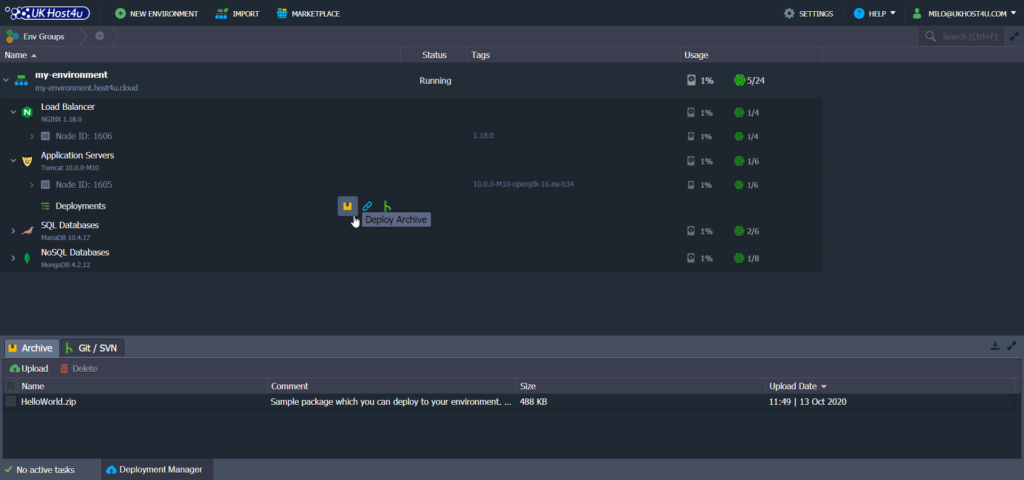Search Knowledge Base by Keyword
Deployment Guide for UKHost4u Cloud Solutions Platform
UKHost4u Cloud Solutions platform supports various ways to automatically deploy your applications. This allows you to choose your favorite options that suit your requirements.
With UKHost4u Cloud Solutions you can access:
- Dashboard: corresponds to deployment via archive (provided either as a local file or URL).
- VCS: allows deploying from your VCS repository (e.g. Git, SVN, Bitbucket).
- Hub Registry: creates a custom container with your application based on the Docker image stored at your public or private registry.
- Plugins: deploys a project using one of the popular software development tools (Ant Task, Eclipse, Intellij IDEA, Maven, or NetBeans), which provides integration with the platform.
We will try to explain in this guide how to deploy via archive and VCS repository.
To use the Deployment Manager or hover over the Deployments section provided for all application servers, simply click on one of the appropriate buttons as you can see here below.

Deploy via Archive: using the two first buttons, you can either deploy from a local file or URL.
Deploy via Git / SVN: to deploy directly from the VCS repository.
PLEASE NOTE:
- VCS deployment type for Java application servers is performed with a help of the Maven build node.
- .NET deployment process for the Windows-based IIS application server is different from the standardized flow described in this guide.
Select your favorite option and proceed with your deployment configuration.
Archive Deployment Configurations
In just a few seconds and very easily, you start deploying your applications by setting up the two parameters:
- Providing the required Archive file
- Specifying the target Environment
Of course, your deployment can be fine-tuned to your specific needs by adjusting the additional configurations.
You will find here below the detailed description of all the option possibilities offered within the deployment frame:
- Local file (or URL): points to the archive file to be deployed, which is automatically selected when installing from the Deployment Manager.
- Environment: selects a target environment for the application server (is automatically selected, when installing from the application server).
- Path: sets the desired custom context; herewith, the available options may be limited due to the used programming language specifics (e.g. Python and Node.js have a single predefined deployment path only)
- Hooks: applies the provided scripts either before or after the deployment process.
- Deploy Strategy: for deployments into the scaled servers, it allows to choose between a relatively quicker Simultaneous deployment variant, which causes a brief downtime, and the Sequential deployment with delay option to perform deployment on servers one-by-one with a set delay between operations, which ensures application uptime.
- Enable zero-downtime deployment: for PHP servers only, it adjusts (if the option is ticked) the deployment flow to avoid application downtime.

Then, click on the Deploy button to start the process.
Git / SVN Deployment Configurations
In just a few seconds and very easily, you start deploying your applications by setting up the two parameters:
- Providing the required Archive file
- Specifying the target Environment
Of course, your deployment can be tuned up to your specific needs by adjusting the additional configurations.
- Repository: allows to select the Git / SVN project from Deployment Manager (or jump to its addition form)
- Branch: defines the used repository branch (master by default)
- Environment: selects a target environment with the application server (is automatically selected, when installing from the application server)
- Path: sets the desired custom context; herewith, the available options may be limited due to the used programming language specifics (e.g. Python and Node.js have a single predefined deployment path only)
- Build: for Java application deployments, it allows to choose the existing Maven to build a node (or add one into the target environment) and, if required, to select repository Working Directory
- Hooks: applies the provided scripts either before or after the deployment process
- Deploy Strategy: for deployments into the scaled servers, it allows to choose between a relatively quicker Simultaneous deployment variant, which causes a brief downtime, and the Sequential deployment with delay option to perform deployment on servers one-by-one with a set delay between operations, which ensures application uptime
- Check and auto-deploy updates: enables periodical check-ups for code changes in your repository (with configurable frequency); if any, project automatic deployment is initiated
- Auto-resolve conflicts: prevents the occurrence of merge conflicts by updating the contradictory files to the repository version (i.e. locally made changes are discarded)
- Enable zero-downtime deployment: for PHP servers only, it adjusts the deployment flow to avoid application downtime

Then, click on the Deploy button to start the process.
This might take a few minutes to complete. Once done, your application should be successfully deployed.
You will also be able to access it with the Open in Browser button, analyze the Logs or manage it with the file manager or via SSH access.

How to edit Git / SVN Projects
If required, you can always adjust your deployed VCS projects by clicking on the Edit button.

Within the opened frame, you can edit the same parameters described above for the deployment frame. For example, it is possible to switch a branch, add hooks, enable updates to auto-deploy, etc.

PLEASE NOTE: If you changed the access credentials to the project’s repository, you need to provide new ones to continue working with this project.
Simply, edit authentication for the repository with the Deployment Manager.

Then, you need to Edit all the already existing projects from this repository.
UKHost4u Cloud Hosting Solutions platform will automatically ask if you wish to update the credentials.

Click Yes to apply for new credentials for the project.
That’s it!
Need further assistance?
Do you have a question or do you need our assistance? Contact our super friendly team, they’ll gladly help you via our Live Chat or our Support ticket system.
